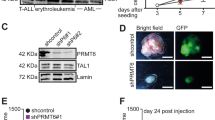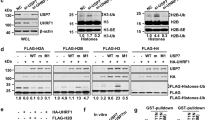Abstract
The Ets transcription factor PU.1 is a hematopoietic master regulator essential for the development of myeloid and B-cell lineages. As we previously reported, PU.1 sometimes represses transcription on forming a complex with mSin3A–histone deacetyl transferase–MeCP2. Here, we show an interaction between PU.1 and DNA methyltransferases, DNA methyltransferase (Dnmt)3a and Dnmt3b (Dnmt3s). Glutathione-S-transferase pulldown assay revealed that PU.1 directly interacted with the ATRX domain of Dnmt3s through the ETS domain. Dnmt3s repressed the transcriptional activity of PU.1 on a reporter construct with trimerized PU.1-binding sites. The repression was recovered by addition of 5-aza-deoxycitidine, a DNA methyltransferase inhibitor, but not trichostatin A, a histone deacetylase inhibitor. Bisulfite sequence analysis revealed that several CpG sites in the promoter region neighboring the PU.1-binding sites were methylated when Dnmt3s were coexpressed with PU.1. We also showed that the CpG sites in the p16INK4A promoter were methylated by overexpression of PU.1 in NIH3T3 cells, accompanied by a downregulation of p16INK4A gene expression. These results suggest that PU.1 may downregulate its target genes through an epigenetic modification such as DNA methylation.
This is a preview of subscription content, access via your institution
Access options
Subscribe to this journal
Receive 50 print issues and online access
$259.00 per year
only $5.18 per issue
Buy this article
- Purchase on Springer Link
- Instant access to full article PDF
Prices may be subject to local taxes which are calculated during checkout








Similar content being viewed by others
Abbreviations
- GST:
-
glutathione-S-transferase
- G418:
-
geneticin
- Tris:
-
2-amino-2-hydroxymethyl-1,3-propanediol
- DMEM:
-
Dulbecco's modified Eagle's minimum essential medium
- HEPES:
-
2-[4-(2-hydroxyethyl)-1-piperazinyl]ethanesulfonic acid
- MOPS:
-
3-morpholinopropanesulfonic acid
- PVDF:
-
polyvinylidene fluoride
- PMSF:
-
phenylmethylsulfonyl fluoride
- EDTA:
-
ethylenediamine-N, N, N′, N′-tetraacetic acid
- SDS:
-
sodium dodecylsulfate
- DOC:
-
sodium deoxycholate
- NP-40:
-
Nodiet P-40
- 5-AZAdC:
-
5-aza-deoxycitidine
- TSA:
-
trichostatin A
- HDAC:
-
histone deacetyl transferase
- CBP:
-
CRE-binding protein
- Dnmt:
-
DNA methyltransferase
- GAPDH:
-
glyceraldehyde-3-phosphate dehydrogenase
References
Bachman KE, Rountree MR, Baylin SB . (2001). J Biol Chem 276: 32282–32287.
Bassuk AG, Leiden JM . (1995). Immunity 3: 223–237.
Bestor T, Laudano A, Mattaliano R, Ingram V . (1988). J Mol Biol 203: 971–983.
Bird AP, Wolffe AP . (1999). Cell 99: 451–454.
Croce LD, Raker VA, Corsaro M, Fazi F, Fanelli M, Fuks F et al. (2002). Science 295: 1079–1082.
Datta J, Ghoshal K, Sharma SM, Tajima S, Jacob ST . (2003). J Cell Biochem 88: 855–864.
Eisenbeis CF, Singh H, Storb U . (1995). Gene Dev 9: 1377–1387.
Fuks F, Burgers WA, Godin N, Kasai M, Kouzarides T . (2001). EMBO J 20: 2536–2544.
Hara E, Smith R, Parry D, Tahara H, Stone S, Peters G . (1996). Mol Cell Biol 16: 859–867.
Herman JG, Graff JR, Myohanen S, Nelkin BD, Baylin SB . (1996). Proc Natl Acad Sci USA 93: 9821–9826.
Hwang CK, Kim CS, Choi HS, McKercher SR, Loh HH . (2004). J Biol Chem 279: 19764–19774.
Jenuwein T, Allis CD . (2001). Science 293: 1074–1080.
Kihara-Negishi F, Yamamoto H, Suzuki M, Yamada T, Sakurai T, Tamura T et al. (2001). Oncogene 20: 6039–6047.
Klemsz MJ, McKercher SR, Celeda A, Maki RA . (1990). Cell 61: 13–124.
Konishi Y, Tominaga M, Watanabe Y, Imamura F, Goldfarb A, Maki R et al. (1999). Oncogene 18: 6795–6805.
Linderson Y, Eberhard D, Malin S, Johansson A, Busslinger M, Pettersson S . (2004). EMBO Rep 3: 291–296.
Majumder S, Ghoshal K, Datta J, Bai S, Dong X, Quan N et al. (2002). J Biol Chem 277: 16048–16058.
Moreau-Gachelin F . (1994). Biochim Biophys Acta 1198: 149–163.
Moreau-Gachelin F, Ray D, Mattei MG, Tambourin P, Tavitian A . (1989). Oncogene 4: 1449–1456.
Moreau-Gachelin F, Wending F, Molina T, Denis N, Titeux M, Grimber G et al. (1996). Mol Cell Biol 16: 2453–2463.
Muller BU, Pabst T, Osato M, Asou N, Johansen LM, Minden MD et al. (2002). Blood 100: 998–1007.
Nagulapalli S, Pongubala JM, Atchison ML . (1995). J Immunol 155: 4330–4338.
Ng HH, Bird A . (1999). Curr Opin Genet Dev 9: 158–163.
Oelgeschlager M, Nuchprayoon I, Luscher D, Friedman AD . (1996). Mol Cell Biol 16: 4717–4725.
Ohtani N, Zebedee Z, Huot TJ, Stinson JA, Sugimoto M, Ohashi Y et al. (2001). Nature 409: 1067–1070.
Oikawa T, Yamada T . (2003). Gene 303: 11–34.
Oikawa T, Yamada T, Kihara-Negishi F, Yamamoto H, Kondoh N, Hitomi Y et al. (1999). Cell Death Differ 6: 599–608.
Okano M, Xie S, Li E . (1998). Nat Genet 19: 219–220.
Pongubala JM, Atchison ML . (1997). Proc Natl Acad Sci USA 94: 127–132.
Rao G, Rekhtman N, Cheng G, Krasikov T, Skoultchi AI . (1997). Oncogene 14: 123–131.
Robertson KD . (2001). Oncogene 20: 3139–3155.
Robertson KD . (2002). Oncogene 21: 5361–5379.
Robertson KD, Ait-Si-Ali S, Yokochi T, Wade PA, Jones PL, Wolffe AP . (2000). Nat Genet 25: 338–342.
Rosenbauer F, Wagner K, Kutok JL, Iwasaki H, Le Beau MM, Okuno Y et al. (2004). Nat Genet 36: 624–630.
Rountree MR, Bachman KE, Baylin SB . (2000). Nat Genet 25: 269–277.
Singal R, Ginder GD . (1999). Blood 93: 4059–4070.
Suzuki M, Yamada T, Kihara-Negishi F, Sakurai T, Oikawa T . (2003). Oncogene 22: 8688–8698.
Tatematsu KI, Yamazaki T, Ishikawa F . (2000). Genes Cells 5: 677–688.
Tenen DG, Hromas R, Licht JD, Zhang DE . (1997). Blood 90: 498–519.
Vangala RK, Heiss-Neumann MS, Rangatia JS, Singh SM, Schoch C, Tenen DG et al. (2003). Blood 101: 270–277.
Walsh CP, Bestor TH . (1999). Genes Dev 13: 26–34.
Yamada T, Kondoh N, Matsumoto M, Yoshida M, Maekawa A, Oikawa T . (1997). Blood 89: 1383–1393.
Yamamoto H, Kihara-Negishi F, Yamada T, Hashimoto Y, Oikawa T . (1999). Oncogene 18: 1495–1501.
Zhang DE, Hetherington CJ, Chen HM, Tenen DG . (1994). Mol Cell Biol 14: 373–381.
Acknowledgements
We wish to thank Dr I Kitabayashi, National Cancer Center, Tokyo, Japan, for expression plasmids of mSin3A and HDAC1, and Dr C Jones, The Salk Institute, La Jolla CA, USA, for pTK-100-Luc reporter plasmid. We also thank Dr N Kondoh, National Defense Medical College, Saitama, Japan, for the helpful advice with respect to bisulfite sequencing analysis. This work was mainly supported by a Grant-in-Aid for Encouragement of Young Scientist (to MS) from the Ministry of Education, Science and Culture of Japan, and a Grant from the Nishi Foundation, Tokyo, Japan. Financial support for TO from Dr J Akiyama, OBGYN Akiyama Memorial Hospital, Hakodate, Dr K Watanabe, Watanabe Clinic, Shizuoka and Dr S Kurakata, Sankyo Ltd, Tokyo, Japan is also acknowledged.
Author information
Authors and Affiliations
Corresponding author
Rights and permissions
About this article
Cite this article
Suzuki, M., Yamada, T., Kihara-Negishi, F. et al. Site-specific DNA methylation by a complex of PU.1 and Dnmt3a/b. Oncogene 25, 2477–2488 (2006). https://doi.org/10.1038/sj.onc.1209272
Received:
Revised:
Accepted:
Published:
Issue Date:
DOI: https://doi.org/10.1038/sj.onc.1209272
Keywords
This article is cited by
-
B1a and B2 cells are characterized by distinct CpG modification states at DNMT3A-maintained enhancers
Nature Communications (2021)
-
Human monocyte-to-macrophage differentiation involves highly localized gain and loss of DNA methylation at transcription factor binding sites
Epigenetics & Chromatin (2019)
-
EID3 directly associates with DNMT3A during transdifferentiation of human umbilical cord mesenchymal stem cells to NPC-like cells
Scientific Reports (2017)
-
CITED2-mediated human hematopoietic stem cell maintenance is critical for acute myeloid leukemia
Leukemia (2015)
-
Expression level and immunolocalization of de novo methyltransferase 3 protein (TuDNMT3) in adult females and males of the two-spotted spider mite, Tetranychus urticae
Experimental and Applied Acarology (2015)



